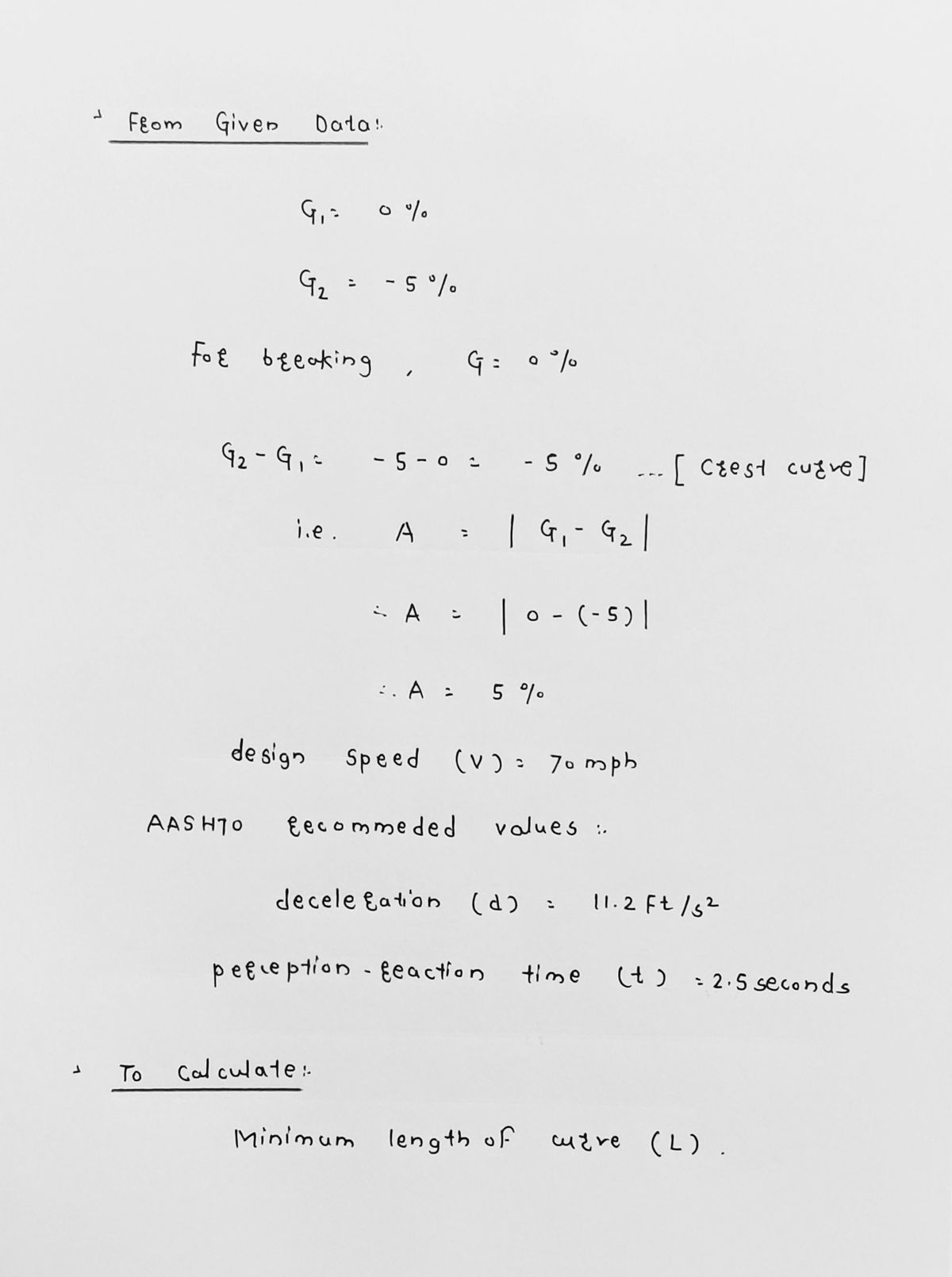
Structural Analysis
6th Edition
ISBN: 9781337630931
Author: KASSIMALI, Aslam.
Publisher: Cengage,
expand_more
expand_more
format_list_bulleted
Concept explainers
Question

Transcribed Image Text:A vertical curve is needed to join to tangents; G₁=0% and G₂=-5%. Assuming a level grade (0%) for braking,
and the AASHTO recommended values for deceleration and perception-reaction time, calculate the minimum
length of curve (ft) needed to satisfy the safety criteria. The design speed is 70 mph.
Response Feedback: G2-G₁ is negative, therefore a crest curve.
A=5
SSD(0%)=726.8 ft
If you assume S<L, Lmin=1224 ft. SSD less than Lmin. The assumption is good.
Expert Solution
arrow_forward
Step 1

Step by stepSolved in 3 steps with 3 images

Knowledge Booster
Learn more about
Need a deep-dive on the concept behind this application? Look no further. Learn more about this topic, civil-engineering and related others by exploring similar questions and additional content below.Similar questions
- A horizontal curve on a four-lane (two lane in each direction) highway (11-ft lanes) has PC at station 124+30 and PT at station 130 + 15. The central angle is 40 degrees, the superelevation is 0.12, and 23.5 ft is cleared (for sight distance) from the inside edge of the innermost lane. Determine a maximum safe speed (assuming current design standards) to the nearest 5 mi/h.arrow_forwardQUESTION 3 A vertical curve is needed to join to tangents; G₁-5% and G₂-2%. Assuming the worst case scenario for braking, and the AASHTO recommended values for deceleration and perception-reaction time, calculate the minimum length of curve (ft) needed to satisfy the safety criteria. The design speed is 50 mph.arrow_forwardthis is one question split by parts a and b.arrow_forward
- A+1 percent grade intersects with a-2 percent grade at station (535+ 24.25) at an elevation of 300 t. (a) if the design speed is 65 mi/h, determine the minimum length (in t) of vertical curve using the rate of vertical curvature. (Assume the stopping sight distance is less than the length of the curve.) it (b) Using the length found in part (a), find the stations and elevations (in R) of the BVC and EVC and the elevation (in t) of each 100 t station. (In the table below, the first row corresponds to the BVC and the last row corresponds to the EVC. Round your elevations to at least one decimal place.) Station Elevation (t) 533 + 00 534 + 00 535 + 00 536 + 00 537 + 00 538 + 00 (c) Using the length found in part (a), find the station and elevation (in t) of the highpoint. station nlevationarrow_forwardA vertical curve is needed to join to tangents; G1=1% and G2=4%. Assuming a level grade (0%) for braking, and the AASHTO recommended values for deceleration and perception-reaction time, calculate the minimum length of curve (ft) needed to satisfy the safety criteria. The design speed is 60 mph.arrow_forwardA vertical curve is needed to join to tangents; G₁=1% and G2-4%. Assuming a level grade (0%) for braking, and the AASHTO recommended values for deceleration and perception-reaction time, calculate the minimum length of curve (ft) needed to satisfy the safety criteria. The design speed is 60 mph. Response Feedback: G2-G₁ is positive, therefore a sag curve. A=3 SSD(0%)=565.5 ft If you assume SL, Lmin-340 ft. SSD is greater than Lmin. The assumption is good.arrow_forward
arrow_back_ios
arrow_forward_ios
Recommended textbooks for you

 Structural Analysis (10th Edition)Civil EngineeringISBN:9780134610672Author:Russell C. HibbelerPublisher:PEARSON
Structural Analysis (10th Edition)Civil EngineeringISBN:9780134610672Author:Russell C. HibbelerPublisher:PEARSON Principles of Foundation Engineering (MindTap Cou...Civil EngineeringISBN:9781337705028Author:Braja M. Das, Nagaratnam SivakuganPublisher:Cengage Learning
Principles of Foundation Engineering (MindTap Cou...Civil EngineeringISBN:9781337705028Author:Braja M. Das, Nagaratnam SivakuganPublisher:Cengage Learning Fundamentals of Structural AnalysisCivil EngineeringISBN:9780073398006Author:Kenneth M. Leet Emeritus, Chia-Ming Uang, Joel LanningPublisher:McGraw-Hill Education
Fundamentals of Structural AnalysisCivil EngineeringISBN:9780073398006Author:Kenneth M. Leet Emeritus, Chia-Ming Uang, Joel LanningPublisher:McGraw-Hill Education
 Traffic and Highway EngineeringCivil EngineeringISBN:9781305156241Author:Garber, Nicholas J.Publisher:Cengage Learning
Traffic and Highway EngineeringCivil EngineeringISBN:9781305156241Author:Garber, Nicholas J.Publisher:Cengage Learning


Structural Analysis (10th Edition)
Civil Engineering
ISBN:9780134610672
Author:Russell C. Hibbeler
Publisher:PEARSON

Principles of Foundation Engineering (MindTap Cou...
Civil Engineering
ISBN:9781337705028
Author:Braja M. Das, Nagaratnam Sivakugan
Publisher:Cengage Learning

Fundamentals of Structural Analysis
Civil Engineering
ISBN:9780073398006
Author:Kenneth M. Leet Emeritus, Chia-Ming Uang, Joel Lanning
Publisher:McGraw-Hill Education


Traffic and Highway Engineering
Civil Engineering
ISBN:9781305156241
Author:Garber, Nicholas J.
Publisher:Cengage Learning